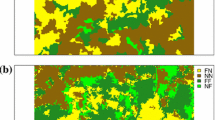Abstract
In Finland, the data for forest management planning has been gathered by stand-level visual field inventories. From the viewpoint of forest inventory and monitoring, this kind of a method has several drawbacks: the delineation of the stands is subjective and the stand borders tend to change during the planning period. As an alternative, a two-phase plot sampling has been suggested, where first phase sample plots are generated and stratified on the basis of remote sensing images and other auxiliary data sources. The second phase sample is allocated to these strata and measured in the field. The gathered information is generalised to the first phase sample plots using suitable estimators. The method has been applied with digitalized aerial photographs by extracting spectral features for first phase sample plots from square windows surrounding them. This method is unable to fully exploit the spatial resolution of aerial orthophotos. As an alternative we suggest image segment-based feature extraction and stratification. The main hypothesis is that the spectral strata produced by segments are more homogenous in relation to the actual stand characteristics than strata derived by the sample plot-based method. The hypothesis was tested using plot-and segment-based approaches as the basis of the stratification. Spectral average and standard deviation features were extracted from square windows surrounding the plots and from image segments. Two different segmentations were tested. The results from two study areas (S 1 and S2) were contradictory. The segment-based stratification produces spectrally more homogeneous segments in both study areas, but it did not result in more homogeneous strata in forest characteristics. In S1 the plot-based approach gave better results than the segment-based approaches. In S2, segment-based approach performed better if only spectral average features were employed in the stratification. The introduction of spectral standard deviation features to the analysis significantly improved the performance of plot-based approach.
Access this chapter
Tax calculation will be finalised at checkout
Purchases are for personal use only
Preview
Unable to display preview. Download preview PDF.
Similar content being viewed by others
References
Hagner, O. 1990. Computer aided forest stand delineation and inventory based on satellite remote sensing. In Proceedings from SNS/IUFRO workshop in Umeå 26–28 February 1990: The usability of remote sensing for forest inventory and planning. Swedish University of Agricultural Sciences. Remote sensing laboratory. Umeå.
Holmgren, P., Thuresson, T. 1995. Avdelningsfritt skogsbruk. Faktaskog Nr 14. Sveriges Lantbruksuniversitet. In Swedish.
Holopainen, M., Wang, G. 1998. The calibration of digitized aerial photographs for forest stratification. International Journal of Remote Sensing 19: 677–696.
Hyyppä, J., Hyyppä, H., Inkinen, M., Engdahl, M., Linko, S., Zhu, Y-H. 2000. Accuracy estimation of various remote sensing data sources in the retrieval of forest stand attributes. Forest Ecology and Management 128: 109–120.
MacQueen, J. 1967. Some methods for classification and analysis of multivariate observations. Volume 1 of Proceedings of the Fifth Berkeley Symposium on Mathematical statistics and probability, pp 281–297. Berkeley, 1967. University of California Press.
Narendra, P., Goldberg, M. 1980. Image segmentation with directed trees. IEEE Transactions on Pattern Analysis and Machine Intelligence, Pami-2: 185–191.
Pekkarinen, A. 2002. Image segment-based spectral features in the estimation of timber volume. Remote Sensing of Environment 82: 349–359.
Poso, S., Paananen, R., Similä, M. 1987. Forest inventory by compartments using satellite imagery. Silva Fennica 21: 69–94.
Poso, S., Waite, M-L. 1996. Sample based forest inventory and monitoring using remote sensing. In Remote sensing and computer technology for natural resource assessment. Research notes 48. University of Joensuu, Faculty of Forestry.
Poso, S., Wang, G., Tuominen, S. 1999. Weighting alternative estimates when using multi-source auxiliary data for forest inventory. Silva Fennica 33: 41–50.
Tokola, T., Pitkänen, J., Partinen, S., Muinonen, E. 1996. Point accuracy of a non-parametric method in estimation of forest characteristics with different satellite materials. International Journal of Remote Sensing 17: 2333–2351.
Tuominen, S., Fish, S., Poso, S. 2001. Combining remote sensing, old inventory data and geostatistical interpolation in multi-source forest inventory. Submitted to Canadian Journal of Forest Research.
Author information
Authors and Affiliations
Editor information
Editors and Affiliations
Rights and permissions
Copyright information
© 2003 Springer Science+Business Media Dordrecht
About this chapter
Cite this chapter
Pekkarinen, A., Tuominen, S. (2003). Stratification of a Forest Area for Multisource Forest Inventory by Means of Aerial Photographs and Image Segmentation. In: Corona, P., Köhl, M., Marchetti, M. (eds) Advances in Forest Inventory for Sustainable Forest Management and Biodiversity Monitoring. Forestry Sciences, vol 76. Springer, Dordrecht. https://doi.org/10.1007/978-94-017-0649-0_9
Download citation
DOI: https://doi.org/10.1007/978-94-017-0649-0_9
Publisher Name: Springer, Dordrecht
Print ISBN: 978-90-481-6466-0
Online ISBN: 978-94-017-0649-0
eBook Packages: Springer Book Archive



